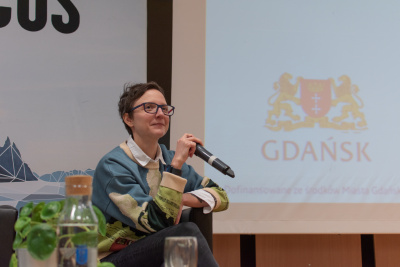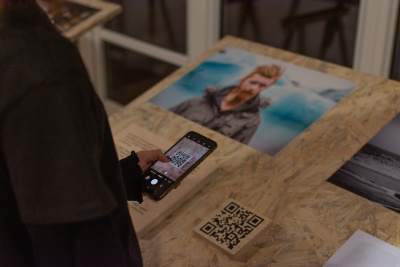
Kaśka Paluch, photo Zuzanna Litwinko
'Noise from Iceland' is an artistic and documentary project that aims to collect field recordings from different corners of Iceland. One of the inspirations for this idea was an encounter with a blind tourist:
‘While working as a guide in the lava cave Raufarhólshellir, I was assigned as a support guide to a blind tourist. It was purely by chance,’ says Kaśka Paluch (this form of the name is used by the artist). ‘We walked at the end of the group and talked a lot; when I felt comfortable enough in conversation to broach the subject, I asked her a question that would probably occur to anyone: what does someone who cannot see Iceland's beautiful sights, for which, after all, one comes here in the first place, get out of such a trip? That tourist's answer made me realise that Iceland has much more to offer than just beautiful sights: the feel of the air on your skin, the textures, the smells – and, of course, the sounds. When we stop and close our eyes, the other senses start working much more intensely. At that moment, the idea began to sprout in me to find out what popular corners of Iceland sound like.’
The artist revealed that she originally intended to record various tourist attractions with all the richness of human-generated sounds, but these plans were thwarted by the COVID-19 pandemic (work started in 2020). As a result of the lockdown, Iceland was deserted, which created a unique opportunity to record the sounds of nature almost without human presence. Among the extraordinary recordings, in addition to the sounds of waterfalls, lakes and caves, were the sound of the interior of a glacier (recorded after descending into a glacial crevasse) and an erupting volcano.
During the meeting, the project's author encouraged the audience to try to make field recordings themselves, which allow one to stop and listen to reality; they may also present documentary value years later, as both sounds and places gradually disappear from maps, significantly influenced by environmental degradation. At the same time, she assured everyone that expensive professional equipment is not necessary to embark on the adventure of field recording - all you need is a phone, headphones, and an appropriate app.
‘Turning on the microphone and putting on the headphones act like a stethoscope applied to nature,’ she added.

As part of the NFF, in the lobby of the Faculty of Philology and the Faculty of History of the UG, you can also see excerpts from the exhibition 'Noise from Iceland - Hidden People', a joint project by Kaśka Paluch and photographer Magdalena Łukasiak (who was unable to make it to the festival for fortuitous reasons). The photographs show remote Icelandic locations and their inhabitants, while the recordings accompanying them (available after scanning the QR code) comprise portraits' protagonists' stories about the 'hidden people' (elves, trolls and other creatures from Icelandic legends), interwoven with fragments of folk tales and folk music. As inclusivity is essential to both artists, the exhibition is accompanied by descriptions of the photographs in Braille so that the visually impaired can also interact with them (similarly, traditional descriptions accompany the sound recordings for the sake of deaf people).
The exhibition can be viewed until December 10 this year.
